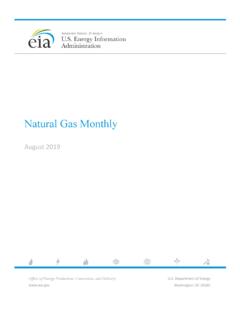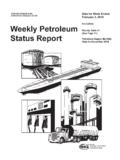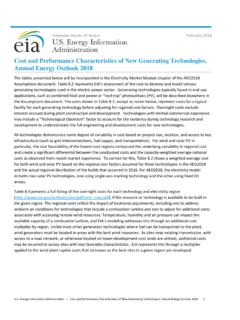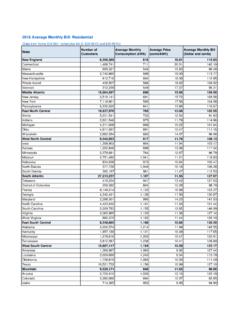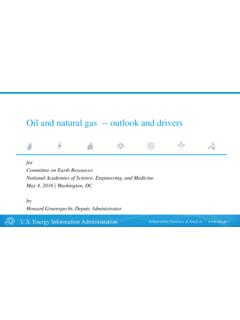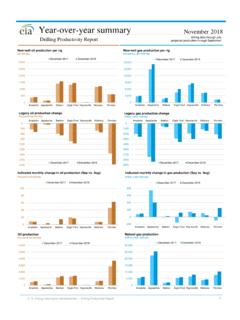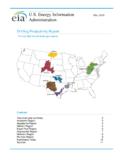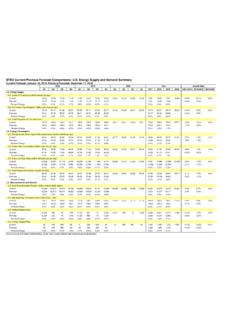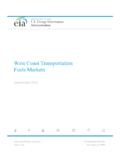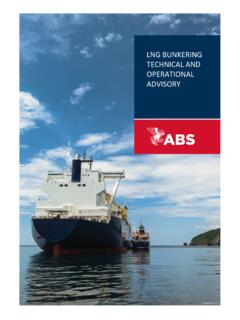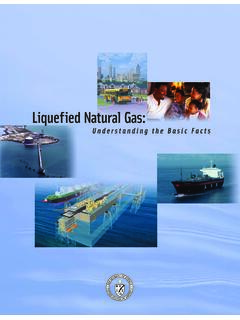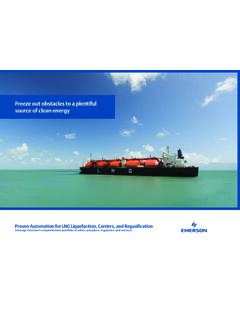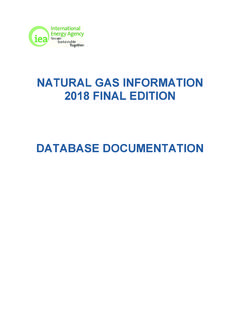Transcription of Country Analysis Executive Summary: Malaysia
1 1 Country Analysis Executive summary : Malaysia Last Updated: January 25, 2021 Overview Malaysia is the second-largest oil and natural gas producer in Southeast Asia and is the fifth-largest exporter of liquefied natural gas (LNG) in the world, as of 2019. It is strategically located on important routes for seaborne energy Malaysia s energy industry is an important sector of growth for the economy. The government has focused on increasing hydrocarbon production through upstream investment and exploration as a driver of economic growth, but pursuing this strategy has become increasingly challenging because production has been declining as a result of maturing fields and a lack of developed new fields. Mahathir Mohamad resigned as Prime Minister on February 24, 2020, and was replaced by Muhyiddin Yassin, who is backed by a new coalition party called Perikatan Nasional.
2 Mahathir Mohamad s resignation was an unexpected announcement and led to the collapse of his own coalition party, which was formed in partnership with his political rival and former deputy prime minister, Anwar Ibrahim. The recent turn of political events, the increasing fragmentation of political parties, and the sudden slowdown of economic activity as a result of the outbreak of the novel coronavirus (COVID-19) are expected to significantly increase the level of uncertainty in the political landscape and may lead to a more complex business environment for international companies operating in Sector organization Recent updates Energy policy in Malaysia is set and overseen by the Economic Planning Unit (EPU) and the Implementation and Coordination Unit (ICU), which both report directly to the Office of the Prime Minister.
3 Malaysia s national oil and natural gas company, Petroliam Nasional Berhad (Petronas), holds exclusive ownership rights to all oil and natural gas exploration and production projects in Malaysia , and its Petroleum Management Unit (PMU) is responsible for managing all upstream licensing procedures. Petronas holds stakes in most of the oil and natural gas blocks in Malaysia , and Petronas financial contributions to government revenue in the form of taxes, dividends, and cash payments comprised about 35% of total government revenue in ExxonMobil, Shell, and ConocoPhillips are the major international oil companies producing the most oil in Malaysia , according to Rystad Energy s production estimates. Murphy Oil 2 divested its Malaysian assets through a share repurchase agreement with Thailand s PTT Exploration and Production Public Company Limited (PTTEP) and left the New opportunities for investment in Malaysia s energy sector have attracted other foreign oil independents and national oil companies such as Repsol (Spain), Pertamina (Indonesia), PetroVietnam (Vietnam), and JX Nippon Oil and Gas (Japan).
4 The state government of Sarawak introduced a new 5% state tax on its crude oil and natural gas sales and exports beginning in January 2019, which Petronas challenged in a legal dispute with the state government. After the Sarawak High Court ruled in favor of the state government, Petronas sought to appeal the decision, but later it reached an out-of -court settlement with the state government and formally withdrew from legal proceedings in August 2020. The state government of Sabah also enacted a similar 5% state tax, in addition to royalties collected on crude oil and natural gas produced in its jurisdiction that took effect in April Petroleum and other liquids Exploration and production According to the Oil & Gas Journal (OGJ), Malaysia held proved oil reserves of billion barrels as of January 2020, the fourth-largest reserves in Asia Pacific after China, India, and Nearly all of Malaysia 's oil comes from offshore fields.
5 Malaysia produces a number of different crude oil blends, which are mainly medium to light, sweet blends (Table 1). Malaysia s Tapis blend, which is extracted from the Tapis field located offshore in the Malay Basin, generally commands a relatively strong price premium to other crude oils on the market because it is considered high Total liquid fuels production in 2019 was an estimated 712,000 barrels per day (b/d), of which about 600,000 b/d was crude oil. Total liquid fuels production has declined after reaching a high point of 762,000 b/d for the decade in 2016 (Figure 1).8 Malaysia s declining production is a result of maturing fields, particularly its larger fields in the shallow waters offshore of Peninsular Malaysia . To offset the decline, Petronas wants to attract new investment for smaller, marginal fields and reverse production declines by using enhanced oil recovery (EOR) techniques.
6 In 2020, Malaysia volunteered to cut its crude oil production by 136,000 b/d from May to July 2020 to comply with the April 15 OPEC+ The agreement also stipulates that Malaysia cut 109,000 b/d from August to December 2020. OPEC members and select non-OPEC members agreed to reduce their production from a baseline in order to rebalance the crude oil market after demand steeply declined as a result of the global outbreak of the novel coronavirus (COVID-19) in early 2020 and the severe restrictions on movement and economic activity that Crude oil prices fell significantly after the sharp drop in demand caused by the severe global restrictions on movement and economic activity and after negotiations at the March 2020 OPEC+ meeting broke down, which led to a temporary surge in production, primarily from Saudi Arabia and 3 Table 1.
7 Selected crude blends from Malaysia Crude blend Classification API gravity Sulfur content Kikeh light, sweet Kimanis light, sweet Labuan medium, sweet Miri medium, sweet Tapis light, sweet Sources: McKinsey Energy Insights Transport and storage Pipelines Malaysia has a relatively limited oil pipeline network and relies on tankers and trucks to distribute products onshore. An oil product pipeline runs from the Dumai oil refinery in Indonesia to the Melaka oil refinery in Melaka City, Malaysia . An interconnecting oil-products pipeline runs from the Melaka refinery through Shell s Port Dickson refinery to the Klang Valley airport and to the Klang oil distribution center. Transit and storage terminals Malaysia wants to expand its oil storage capacity because its need for more oil storage is growing because of increasing crude oil trade in the region.
8 Singapore also faces capacity constraints to oil storage, which Malaysia seeks to capitalize on by becoming an alternative provider for oil storage in the 4 The Pengerang oil storage terminal in Johor completed phase 2 of its construction and increased its crude oil storage capacity to million barrels for crude oil and petroleum product storage. It has now begun phase 3 of construction, which it expects to complete by mid-2021 and to add about million barrels of storage for clean petroleum products. The Pengerang facility is Malaysia s largest commercial oil storage facility and is owned and operated by a joint venture consisting of Vopak (44%), Dialog Group (46%), and the state government of Johor (10%).13 State-owned Sabah Oil & Gas Development Corporation Sendirian Berhad signed an agreement with Petroventure Energy Sendirian Berhad to construct a crude oil storage and refining facility in Sipitang Oil & Gas Industrial Park in Sabah.
9 The storage facility is expected to be completed in 3 5 years and have a capacity of million Refining and refined oil products Malaysia has invested heavily in refining activities during the past two decades and can now meet most of its demand for petroleum products with domestic supplies. Malaysia has about 880,000 barrels per day (b/d) of refining capacity at seven facilities (Table 2).15 As part of Malaysia s goal to compete with the oil refining and storage hub in Singapore, Petronas has nearly completed a refining and petrochemicals integrated development project (RAPID) in Johor, located at the southern tip of Peninsular Malaysia . This project has a nameplate capacity of 279,000 b/d and is expected to be fully commissioned by 2021. The project was delayed because of two fires: one in April 2019 at an atmospheric residue desulphurization unit, which led to a shutdown, and another in March 2020 at a diesel hydrotreater The RAPID facility will be the Country s first refinery to produce diesel and gasoline that meet the Euro V standard, which lowers carbon dioxide emission levels.
10 17 The Pengerang Energy Complex is currently developing a condensate splitter and it expects the project to be complete by 2024. Construction was to begin in 2020, but the start date reportedly has been delayed because of the pandemic (Table 3).18 5 Table 2. Malaysia 's existing refineries Refinery name Operator Status Notes Nameplate capacity (barrels per day) Melaka 1 (PSR-1) Petronas Operational Distills sweet crude oil and condensate 88,400 Melaka 2 (PSR-2) Petronas and ConocoPhillips JV Operational Processes sour crude oil grades 158,100 Port Dickson Malaysia Hengyuan International Ltd. (China) Operational Supplies solely domestic market; can accept heavier crude oil grades 135,000 Port Dickson San Miguel/Petron (Philippines) Operational 79,100 Kerteh Petronas Operational Processes naphtha condensates through a splitter 112,800 Kemaman Kemaman Bitumen Company Operational Converts heavy crude oils to bitumen 27,900 Pengerang RAPID Petronas Under maintenance Facility shut down in March 2020; restart expected 2021 279,000 Total 880,300 Source: FACTS Global Energy, Petronas Table 3.
